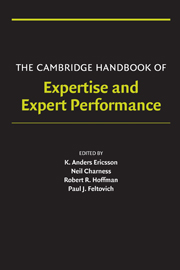Book contents
- Frontmatter
- Contents
- Acknowledgments
- Contributors
- PART I INTRODUCTION AND PERSPECTIVE
- PART II OVERVIEW OF APPROACHES TO THE STUDY OF EXPERTISE – BRIEF HISTORICAL ACCOUNTS OF THEORIES AND METHODS
- PART III METHODS FOR STUDYING THE STRUCTURE OF EXPERTISE
- 8 Observation of Work Practices in Natural Settings
- 9 Methods for Studying the Structure of Expertise: Psychometric Approaches
- 10 Laboratory Methods for Assessing Experts' and Novices' Knowledge
- 11 Task Analysis
- 12 Eliciting and Representing the Knowledge of Experts
- 13 Protocol Analysis and Expert Thought: Concurrent Verbalizations of Thinking during Experts' Performance on Representative Tasks
- 14 Simulation for Performance and Training
- PART IV METHODS FOR STUDYING THE ACQUISITION AND MAINTENANCE OF EXPERTISE
- PART V DOMAINS OF EXPERTISE
- PART VI GENERALIZABLE MECHANISMS MEDIATING EXPERTISE AND GENERAL ISSUES
- Author Index
- Subject Index
- References
12 - Eliciting and Representing the Knowledge of Experts
from PART III - METHODS FOR STUDYING THE STRUCTURE OF EXPERTISE
- Frontmatter
- Contents
- Acknowledgments
- Contributors
- PART I INTRODUCTION AND PERSPECTIVE
- PART II OVERVIEW OF APPROACHES TO THE STUDY OF EXPERTISE – BRIEF HISTORICAL ACCOUNTS OF THEORIES AND METHODS
- PART III METHODS FOR STUDYING THE STRUCTURE OF EXPERTISE
- 8 Observation of Work Practices in Natural Settings
- 9 Methods for Studying the Structure of Expertise: Psychometric Approaches
- 10 Laboratory Methods for Assessing Experts' and Novices' Knowledge
- 11 Task Analysis
- 12 Eliciting and Representing the Knowledge of Experts
- 13 Protocol Analysis and Expert Thought: Concurrent Verbalizations of Thinking during Experts' Performance on Representative Tasks
- 14 Simulation for Performance and Training
- PART IV METHODS FOR STUDYING THE ACQUISITION AND MAINTENANCE OF EXPERTISE
- PART V DOMAINS OF EXPERTISE
- PART VI GENERALIZABLE MECHANISMS MEDIATING EXPERTISE AND GENERAL ISSUES
- Author Index
- Subject Index
- References
Summary
Keywords: knowledge elicitation, expert systems, intelligent systems, methodology, Concept Maps, Abstraction-Decompo- sition, critical decision method
Introduction
The transgenerational transmission of the wisdom of elders via storytelling is as old as humanity itself. During the Middle Ages and Renaissance, the Craft Guilds had well-specified procedures for the transmission of knowledge, and indeed gave us the developmental scale that is still widely used: initiate, novice, apprentice, journeyman, expert, and master (Hoffman, 1998). Based on interviews and observations of the workplace, Denis Diderot (along with 140 others, including Emile Voltaire) created one of the great works of the Enlightenment, the 17 volume Encyclopedie (Diderot, 1751–1772), which explained many “secrets” – the knowledge and procedures in a number of tradecrafts. The emergent science of psychology of the 1700s and 1800s also involved research that, in hindsight, might legitimately be regarded as knowledge elicitation (KE). For instance, a number of studies of reasoning were conducted in the laboratory of Wilhelm Wundt, and some of these involved university professors as the research participants (Militello & Hoffman, forthcoming). In the decade prior to World War I, the stage was set in Europe for applied and industrial psychology; much of that work involved the systematic study of proficient domain practitioners (see Hoffman & Deffenbacher, 1992).
The focus of this chapter is on a more recent acceleration of research that involves the elicitation and representation of expert knowledge (and the subsequent use of the representations, in design).
- Type
- Chapter
- Information
- The Cambridge Handbook of Expertise and Expert Performance , pp. 203 - 222Publisher: Cambridge University PressPrint publication year: 2006
References
- 63
- Cited by



